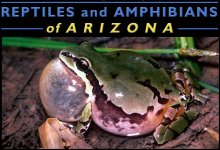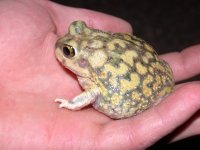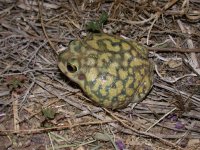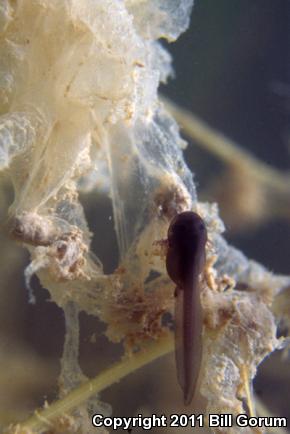| Range: |
 |
| Other Names: |
|
| Description: |
Up to 3.5 inches in length, Couch's spadefoot is a green or yellowish-green toad. Females have dark reticulations, whereas males are lighter overall with faint dark spots, reduced reticulations, or they may lack dark markings altogether. Males also tend to be smaller than females. This species has the large eyes characteristic of spadefoots, and an elongated, sickle-shaped horny tubercle on the underside of each rear foot, which it uses to dig itself into the ground. Couch's spadefoot lacks a raised boss between the eyes. Tadpoles are dark gray to bronze or black with eyes close together and set high on the head. They can grow to 1.25 inch. |
| Similar Species: |
It differs from the other spadefoots (Plains and New Mexico) in New Mexico by having a dorsum of yellow or greenish background color and in the absence of a bony boss between the eyes. The metatarsal tubercle is elongate and sickle-shaped rather than wedge-shaped as in the other spadefoots in the state. |
| Habitat: |
Couch's spadefoots is found primarily in Chihuahuan Deserts and associated grasslands. Occasional individuals are found in lower montane woodlands in southeastern Arizona. This is the most desert-adapted of our anurans and can be encountered in any of the arid western desert valleys capable of supported rain pools that last at least 7-8 days. Breeding ponds are typically in the valleys, but can be found in lower rocky arroyos and canyons, as well. Couch's spadefoots are sometimes found on the edge of agriculture, but rarely stray very far into croplands. |
| Behavior: |
Couch's spadefoots remain buried in the soil for 8-10 months and then emerge at the onset of the summer monsoons. This species is frequently encountered on roads during warm, humid summer nights. Adults are nocturnal, but metamorphs are often active by day. |
| Hibernation: |
Underground |
| Reproduction: |
During the first night of or after the first significant summer storm, Couch's spadefoots move to rain-filled temporary pools for a night or two of frantic breeding and foraging, and then may remain active for as long as moist, warm conditions persist, often traveling far from the breeding ponds. Although most breeding is timed to the first summer storm, occasional breeding congregations can be found throughout the summer. Eggs are usually laid the first night that ponds fill, and are deposited on submerged vegetation in small masses that hatch within 36 hours. Tadpoles can metamorphose in as little as 7-8 days. Drying of a pond stimulates rapid metamorphosis and smaller toadlets. The call, given by males as they float in the breeding pond, is a plaintive "wah! wah!", suggestive of a bleating sheep. The call carries well on humid summer evenings and is a sure sign that the often long-awaited summer monsoon has finally begun. |
| Diet: |
Couch's spadefoot will eat anything that moves and fits into its mouth. Winged termites, which are high in fat content, also emerge with the first monsoon storms, and often make up a high percentage of the spadefoot's diet. A Couch's spadefoot can eat enough termites during one or two nights to survive and breed for a year. Tadpoles are carnivorous; cannibalism has been documented. |
Sources:


|















